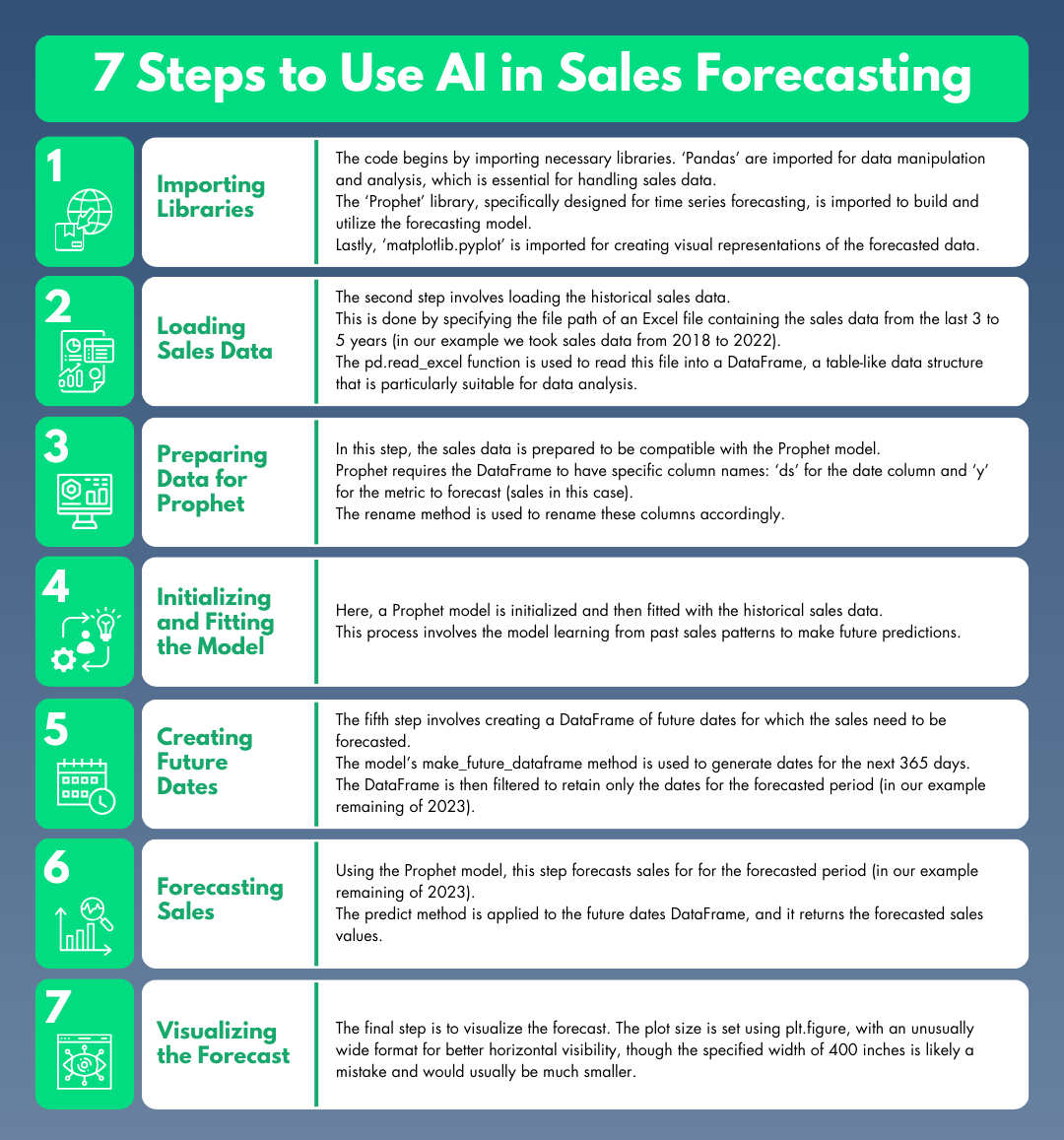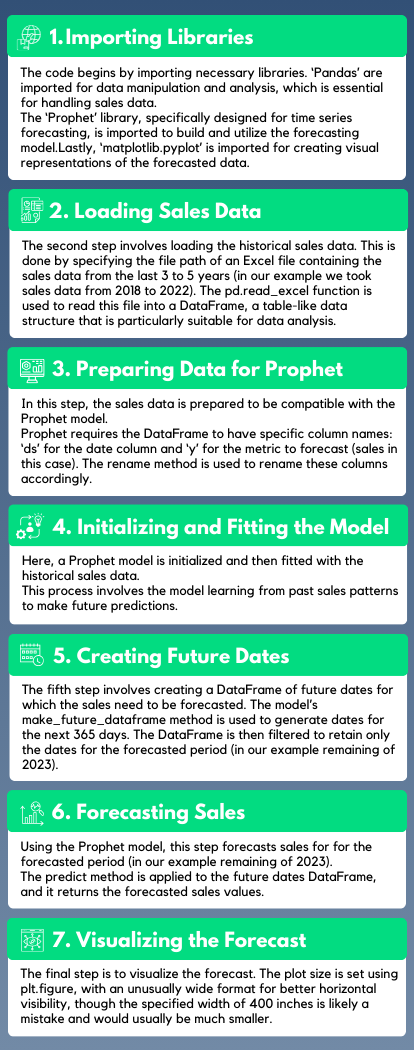You are logged in as:
![]()
Author: Christian Martinez, December 2023
Table of Contents
Sales forecasting is crucial for long-term business growth, but it’s often imprecise and consumes a lot of time.
A Forbes survey found that 74% of large B2B companies ($10B+ annual sales) do weekly forecasting, yet 69% of all B2B companies, regardless of size, find their forecasting efforts ineffective.
That’s quite a bit of inefficiency, isn’t it?
McKinsey’s research in 2022 highlighted the superiority of AI models compared to traditional spreadsheet-based analytics.
For example, in supply chain operations (the area in which I have been working for 8 years); when AI-driven forecasting is applied; it can lead to significant benefits, including a 20% to 50% reduction in errors and a potential decrease in up to 65% in lost sales and product unavailability.
Now AI is everywhere, and is cheaper than ever to implement it.
You as a CFOs or a Finance Leader should consider the potential advantages of adopting these AI-driven approaches in their forecasting routines for improved efficiency and outcomes.
Choosing the right model for you is hard especially when balancing the need for accuracy with the practicalities of implementation.
From traditional methods relying on historical data to advanced AI-driven approaches, you can explore a spectrum of tools designed to cater to various industries and business scales.
We aim to demystify these complex models, translating them into actionable insights for you, a busy financial professional.
This table below serves as your compass in navigating the diverse landscape of sales forecasting techniques.
You can also download the original PDF version of the table (easier for readability and further use).
[ninja_tables id=”2928″]
Think of this table as a map to understand the possibilities that artificial intelligence brings to the table. But, how to decide which one to use in a very quick and efficient way?
We have created this decision tree for you:

Now I want to show you how to implement one of my favorite AI advanced Models: Prophet.
It is an open-source algorithm developed by Facebook for time series forecasting.
Think about this AI tool/algorithm like a sophisticated calendar that helps predict sales by considering special events, holidays, and other patterns that happen over time.
Prophet is particularly effective for business forecasts with daily observations that display patterns on different time scales, such as weekly and yearly, as well as holidays and other recurring events.
We like Prophet because it is user-friendly, even for those with limited experience in time series analysis whilst still being reliable. Moreover, it automates many of the tricky parts of time series forecasting, like trend detection and seasonality decomposition.
If your sales data have gaps or missing values, Prophet can handle these effectively. On the flip side, be aware that sales can be influenced by a wide range of factors not captured in historical data (e.g., market trends, competitive actions, economic changes).
Prophet, like any algorithm, can’t account for these if they’re not in the data. Remember, trash in, trash out!
The accuracy of any forecasting model, including this one, is highly dependent on the quality of the input data. Poor quality or insufficient data can lead to inaccurate forecasts.
In more technical terms, Prophet operates on an additive model where non-linear trends are fit with daily, weekly, and yearly seasonality, plus holiday effects. The model decomposes a time series into three main components: trend, seasonality, and holidays.
Prophet employs a Bayesian framework for parameter estimation, using Markov Chain Monte Carlo (MCMC) methods which is a type of the famous “Monte Carlo Simulations” used in finance. This statistical approach allows for the automatic handling of outliers and missing data, and the additive nature of the model components makes it interpretable and adaptable to many different types of time series data.
For this, you will need Python.
Note: If you don’t know yet how to use Python, we (Nicolas & Christian) have taught 100 finance professionals how to use Python in our Advanced ChatGPT for Finance course. Reach out to us if you want to know more.
Here is the code (feel free to steal it!)
(You can also download the Google Colab Notebook and reuse it for yourself)
# Step 1: Importing Libraries
import pandas as pd from prophet import Prophet
import matplotlib.pyplot as plt from openpyxl
import Workbook from openpyxl.drawing.image
import Image
# Step 2: Loading Sales Data
file_path = ‘/content/sales_data_2018_to_2022.xlsx’ # Replace with your file path
sales_data = pd.read_excel(file_path)
# Step 3: Preparing Data for Prophet
sales_data.rename(columns={‘Date’: ‘ds’, ‘Sales’: ‘y’}, inplace=True)
# Step 4: Initializing and Fitting the Model
model = Prophet()
model.fit(sales_data)
# Step 5: Creating Future Dates for Prediction
future_dates = model.make_future_dataframe(periods=365)
future_dates = future_dates[future_dates[‘ds’].dt.year == 2023]
# Step 6: Forecast sales for 2023
forecast = model.predict(future_dates)
# Step 7: Visualize and Save the Forecast
fig = model.plot(forecast, xlabel=’Date’, ylabel=’Sales’)
plt.title(‘Sales Forecast for 2023 using Prophet’)
# Save the plot as an image BEFORE calling show
plt.savefig(‘forecast_plot.png’)
# Now display the plot
plt.show()
# Insert the Image into an Excel File
wb = Workbook()
ws = wb.active
# Ensure the path is correct when loading the image
img = Image(‘forecast_plot.png’)
ws.add_image(img)
# Save the workbook with the image
wb.save(‘forecast_in_excel.xlsx’)
We have made comments in the code so you can use it straight away with your data but also, we will explain each step of the process on how to apply Prophet below.
Here is a detailed explanation of each of the steps of the process:


In the code, the model.plot method is used to create the forecast plot, labeling the axes for clarity. A title is added to the plot for context, and plt.show() displays the final visualization.
There is also the last bit of the code that saves the image directly in Excel for you!
In this visual, the historical sales data is used by the Prophet model to understand the pattern in the sales over time. The model then uses this understanding to forecast future sales.

Each black dot represents an actual observed data point. These are the historical sales data points from 2018 to the end of 2022.
The dark blue line in the graph shows the predicted central trend of sales according to the model.
The light blue shading represents the uncertainty interval of the forecast. It shows the range within which the actual values are expected to fall with a certain probability.
The lighter the blue, the lower the probability, hence it’s wider to express greater uncertainty further out into the future.
Typically, Prophet provides a default 80% or 95% confidence interval for its forecasts.
If you want to learn more about other algorithms like random forest or linear regression, here are two articles that describe how to use these algorithms for forecasting in finance:
One of the main questions I always get is: How to export this to Excel?

Therefore, we have also included this feature at the bottom of the Python code.
You just need to install this extra library and run the code below.
[ ] pip install openpyxl
Requirement already satisfied: openpyxl in /usr/local/lib/python3.10/dist-packages (3.1.2)
Requirement already satisfied: et-xmlfile in /usr/local/lib/python3.10/dist-packages (1.1.0)
[ ] # Save the forecast to an Excel file
forecast.to_excel('forecast_2023.xlsx', index=False)
